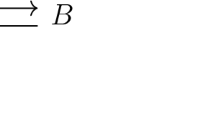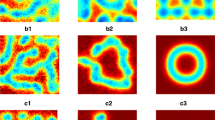Abstract
Turing patterns can be observed in reaction-diffusion systems where chemical species have different diffusion constants. In recent years, several studies investigated the effects of noise on Turing patterns and showed that the parameter regimes, for which stochastic Turing patterns are observed, can be larger than the parameter regimes predicted by deterministic models, which are written in terms of partial differential equations (PDEs) for species concentrations. A common stochastic reaction-diffusion approach is written in terms of compartment-based (lattice-based) models, where the domain of interest is divided into artificial compartments and the number of molecules in each compartment is simulated. In this paper, the dependence of stochastic Turing patterns on the compartment size is investigated. It has previously been shown (for relatively simpler systems) that a modeler should not choose compartment sizes which are too small or too large, and that the optimal compartment size depends on the diffusion constant. Taking these results into account, we propose and study a compartment-based model of Turing patterns where each chemical species is described using a different set of compartments. It is shown that the parameter regions where spatial patterns form are different from the regions obtained by classical deterministic PDE-based models, but they are also different from the results obtained for the stochastic reaction-diffusion models which use a single set of compartments for all chemical species. In particular, it is argued that some previously reported results on the effect of noise on Turing patterns in biological systems need to be reinterpreted.










Similar content being viewed by others
References
Asslani M, Di Patti F, Fanelli D (2012) Stochastic Turing patterns on a network. Phys Rev E 86:046105
Barrass I, Crampin E, Maini P (2006) Mode transitions in a model reaction-diffusion system driven by domain growth and noise. Bull Math Biol 68:981–995
Biancalani T, Fanelli D, Di Patti F (2010) Stochastic Turing patterns in a Brusselator model. Phys Rev E 81:046215
Biancalani T, Galla T, McKane A (2011) Stochastic waves in a Brusselator model with nonlocal interaction. Phys Rev E 84:026201
Black A, McKane A (2012) Stochastic formulations of ecological models and their applications. Trends Ecol Evolut 27(6):337–345
Butler T, Goldenfeld N (2011) Fluctuation-driven Turing patterns. Phys Rev E 84:011112
Cao Y, Li H, Petzold L (2004) Efficient formulation of the stochastic simulation algorithm for chemically reacting systems. J Chem Phys 121(9):4059–4067
Crampin E, Gaffney E, Maini P (1999) Reaction and diffusion on growing domains: scenarios for robust pattern formation. Bull Math Biol 61:1093–1120
Engblom S, Ferm L, Hellander A, Lötstedt P (2009) Simulation of stochastic reaction-diffusion processes on unstructured meshes. SIAM J Sci Comput 31:1774–1797
Erban R, Chapman SJ (2007) Reactive boundary conditions for stochastic simulations of reaction-diffusion processes. Phys Biol 4(1):16–28
Erban R, Chapman SJ (2009) Stochastic modelling of reaction-diffusion processes: algorithms for bimolecular reactions. Phys Biol 6(4):046001
Erban R, Chapman SJ, Maini P (2007) A practical guide to stochastic simulations of reaction-diffusion processes. 35 pp. http://arxiv.org/abs/0704.1908
Erban R, Flegg M, Papoian G (2014) Multiscale stochastic reaction-diffusion modelling: application to actin dynamics in filopodia. Bull Math Biol 76(4):799–818
Fange D, Elf J (2006) Noise-induced Min phenotypes in E. coli. PLoS Computat Biol 2(6):637–648
Ferm L, Hellander A, Lötstedt P (2010) An adaptive algorithm for simulation of stochastic reaction-diffusion processes. J Comput Phys 229:343–360
Flegg M, Chapman J, Erban R (2012) The two-regime method for optimizing stochastic reaction-diffusion simulations. J R Soc Interface 9(70):859–868
Flegg M, Rüdiger S, Erban R (2013) Diffusive spatio-temporal noise in a first-passage time model for intracellular calcium release. J Chem Phys 138:154103
Franz B, Flegg M, Chapman J, Erban R (2013) Multiscale reaction-diffusion algorithms: PDE-assisted Brownian dynamics. SIAM J Appl Math 73(3):1224–1247
Fu Z, Xu X, Wang H, Quoyang Q (2008) Stochastic simulation of Turing patterns. Chin Phys Lett 25(4):1220–1223
Gibson M, Bruck J (2000) Efficient exact stochastic simulation of chemical systems with many species and many channels. J Phys Chem A 104:1876–1889
Gillespie D (1977) Exact stochastic simulation of coupled chemical reactions. J Phys Chem 81(25):2340–2361
Hattne J, Fange D, Elf J (2005) Stochastic reaction-diffusion simulation with MesoRD. Bioinformatics 21(12):2923–2924
Hellander A, Hellander S, Lötstedt P (2012) Coupled mesoscopic and microscopic simulation of stochastic reaction-diffusion processes in mixed dimensions. Multiscale Modeling Simul 10(2):585–611
Hellander S, Hellander A, Petzold L (2012) Reaction-diffusion master equation in the microscopic limit. Phys Rev E 85:042901
Hori Y, Hara S (2012) Noise-induced spatial pattern formation in stochastic reaction-diffusion systems. In: Proceedings of 51st IEEE Conference on Decision and Control, pp 1053–1058
Hu J, Kang H, Othmer H (2014) Stochastic analysis of reaction-diffusion processes. Bull Math Biol 76(4):854–894
Isaacson S (2009) The reaction-diffusion master equation as an asymptotic approximation of diffusion to a small target. SIAM J Appl Math 70(1):77–111
Isaacson S, Peskin C (2006) Incorporating diffusion in complex geometries into stochastic chemical kinetics simulations. SIAM J Sci Comput 28(1):47–74
Kang H, Zheng L, Othmer H (2012) A new method for choosing the computational cell in stochastic reaction-diffusion systems. J Math Biol 65(6–7):1017–1099
Kepper P, Castets V, Dulos E, Boissonade J (1991) Turing-type chemical patterns in the chlorite-iodide-malonic acid reaction. Phys D 49:161–169
Li F, Cao Y (2012) Multiscale discretization for reaction diffusion systems. In: Proceedings of the 2012 International Conference on Bioinformatics and Computational Biology (Editors: Hamid R. Arabnia, Quoc-Nam Tran Associate Editors: Andy Marsh, Ashu M. G. Solo), Las Vegas, Nevada, USA, pp 305–311
Li F, Cao Y (2014) Optimal discretization size and multigrid discretization method for 1D multiscale reaction diffusion systems (submitted)
Maini P, Woolley T, Baker R, Gaffney E, Seirin Lee S (2012) Turing’s model for biological pattern formation and the robustness problem. Interface Focus 2:487–496
McKane A, Biancalani T, Rogers (2014) Stochastic pattern formation and spontaneous polarization: the linear noise approximation and beyond. Bull Math Biol 76(4):859–921
Murray J (2002) Mathematical biology. Springer, Berlin
Qiao L, Erban R, Kelley C, Kevrekidis I (2006) Spatially distributed stochastic systems: equation-free and equation-assisted preconditioned computation. J Chem Phys 125:204108
Quyang Q, Swinney H (1991) Transition from a uniform state to hexagonal and striped Turing patterns. Nature 352:610–612
Satnoianu R, Menzinger M, Maini P (2000) Turing instabilities in general systems. J Math Biol 41:493–512
Schnakenberg J (1979) Simple chemical reaction systems with limit cycle behaviour. J Theor Biol 81:389–400
Scott M, Poulin F, Tang H (2011) Approximating intrinsic noise in continuous multispecies models. Proc R Soc A 467:718–737
Sick S, Reinker S, Timmer J, Schlake T (2006) WNT and DKK determine hair follicle spacing through a reaction-diffusion mechanism. Science 314:1447–1450
Subramanian K, Li F, Paul MR, Cao Y, Tyson JJ (2014) Spatiotemporal model of PopZ localization in Caulobacter crescentus (in preparation)
Turing A (1952) The chemical basis of morphogenesis. Philos Trans R Soc Lond 237:37–72
Twomey A (2007) On the stochastic modelling of reaction-diffusion processes. M.Sc. Thesis, University of Oxford, United Kingdom, September 2007.
Vigelius M, Meyer B (2012) Stochastic simulations of pattern formation in excitable media. PLoS One 7(8):e45208
Woolley T, Baker R, Gaffney E, Maini P (2011a) Power spectra methods for a stochastic description of diffusion on deterministically growing domains. Phys Rev E 84:021915
Woolley T, Baker R, Gaffney E, Maini P (2011b) Stochastic reaction and diffusion on growing domains: understanding the breakdown of robust pattern formation. Phys Rev E 84:046216
Woolley T, Baker R, Gaffney E, Maini P, Seirin-Lee S (2012) Effects of intrinsic stochasticity on delayed reaction-diffusion patterning systems. Phys Rev E 85:051914
Acknowledgments
The research leading to these results has received funding from the European Research Council under the European Community’s Seventh Framework Programme (FP7/2007-2013) / ERC Grant Agreement No. 239870. This publication was based on work supported in part by Award No. KUK-C1-013-04, made by King Abdullah University of Science and Technology (KAUST). Radek Erban would also like to thank the Royal Society for a University Research Fellowship; Brasenose College, University of Oxford, for a Nicholas Kurti Junior Fellowship; and the Leverhulme Trust for a Philip Leverhulme Prize. Yang Cao’s work was supported by the National Science Foundation under awards DMS-1225160 and CCF-0953590, and the National Institutes of Health under award GM078989.
Author information
Authors and Affiliations
Corresponding author
Rights and permissions
About this article
Cite this article
Cao, Y., Erban, R. Stochastic Turing Patterns: Analysis of Compartment-Based Approaches. Bull Math Biol 76, 3051–3069 (2014). https://doi.org/10.1007/s11538-014-0044-6
Received:
Accepted:
Published:
Issue Date:
DOI: https://doi.org/10.1007/s11538-014-0044-6




